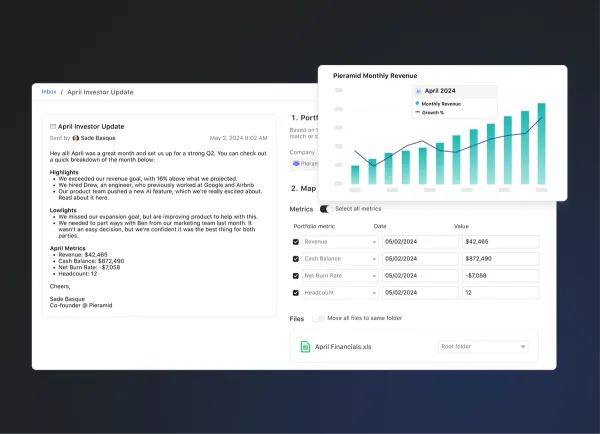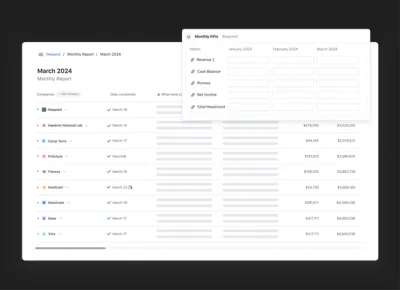
The deal flow process is arguably the most important operational functions at a VC firm. From an outsider's perspective, the way a VC firm runs its deal flow process can be mysterious. It’s the secret recipe that helps VC firms find and invest in the best-performing startups resulting in the biggest returns for their LPs. In this article we’re breaking down the deal flow process: what it is and why it matters.
Defining deal flow in venture capital
Deal flow is defined as the process investors run to attract potential investments, narrow down those opportunities, and then make a final investment decision. How a venture capital firm runs this process, and the quality of investments in their deal pipeline, is what separates great investors from the rest of the pack.
The process of building great deal flow is similar to a sales funnel. Investors want a lot of leads (potential investments) coming to them at the top of their funnel to increase their odds of finding winners. What’s most important though is the quality of those leads. Too much inbound interest from startups that are not aligned with the fund’s thesis is overwhelming and distracting for investors. This is why it’s important for startups to do their research before reaching out to an investor. Similarly, it’s why investors often consider companies that come to them from a referral more credible opportunities -- those companies have already been pre-vetted by someone in their network.
Ultimately, investors care about both volume and quality when building their deal flow pipeline. Maximizing the number of high-quality leads ensures investors are spending their time reviewing opportunities that can actually result in an investment.
Why startups should be familiar with the deal flow process
It’s important for startups to be familiar with the deal flow process so they can engage with the right type of investors, in the right way. When startups fundraise with a solid understanding of the deal flow process they can save themselves time and increase their likelihood of securing funding.
According to a survey from more than 900 VC’s, investors are most likely to source a deal from the following channels:
- 30% - former colleagues or work acquaintances
- 30% - VCs initiating contact with entrepreneurs
- 20% - other investors
- 10% - cold outreach from startups
- 8% - existing portfolio companies
What this means for startups is they shouldn’t rely on cold outbound alone. They’re more likely to stand out to an investor if they can get a warm intro from a personal connection, another relevant investor, or even from a current portfolio company. Founders should invest more time deepening relationships in their networks as opposed to a spray-and-pray cold outbound approach.
A great way for founders to strengthen their relationships with their networks is to send out monthly communications to keep their potential investors, friends, and colleagues engaged.
Get started sending regular updates with Visible.
If a company is going to send a cold outreach to an investor it’s important to understand just how much inbound interest investors receive on a weekly basis. It’s reported that small VC firms receive about 30 inbound messages from startups per week while larger firms can receive more than 200 (source). Here's what this means for startups:
- Don’t be discouraged if an investor doesn’t respond to your cold outreach; they’re busy making their way through all the other inbound interest from the week
- Your pitch deck needs to be clear, concise, and compelling
- Make sure you research the investor in advance and are confident your company fits their investment thesis; otherwise, you’re wasting multiple people's time
Related resource: Pitch Deck 101: How Many Slides Should My Pitch Deck Have?
It’s also important for startups to understand that investors only invest in about 1% of the companies that go through their pipeline. While this may sound daunting, this advice from VC investor Krittr highlights the optimistic mindset founders should take.
“This is the first thing that is important to understand — VC firms want you to succeed. We want you to get the money, and grow. All we want is a strong enough reason to give you the money. Remember this, this mindset shift does wonders.”
Stages of the deal flow process in venture capital
The deal flow process is commonly broken down into seven phases with a decreasing number of companies making it to the next phase. During this process, investors are collecting more information and building conviction about whether a company is a fit for their firm or not. A more in-depth breakdown of each step can be found below.
1. Sourcing
Sourcing is the process of VCs finding potential investment opportunities. To source deals investors will do things like attend networking events (demo days, pitch competitions, industry conferences), research market activity, and meet with other VCs or incubators/accelerators to discuss deal opportunities.
2. Screening
During the screening process, investors will rely on basic assets such as pitch decks to determine which opportunities are worth digging into on a deeper level.
Share your deck with confidence and track engagement rates with Visible.
3. First meeting
When investors believe the company has the potential to be a good investment opportunity based on their initial pitch deck, they will be invited to join a first meeting with the firm. At this stage, investors are trying to better understand the dynamics of the leadership team, whether the company has a competitive advantage, and the market health of the specific sector.
This may lead to additional follow-up meetings where more in-depth questions are asked by the investment team.
Learn more about preparing for the first meeting.
4. Due diligence
If the investment team has built conviction on a company based on the initial meetings they will kick off a more thorough due diligence process. During this phase, the VC is trying to gain an in-depth understanding and evidence of the company’s financial, technological, legal, and market opportunities and risks.
Here is a breakdown of the topics investors evaluate at this stage
- Market - The size of the market, level of maturity, predicted growth and trends, competitive activity, and regulatory changes
- Business - How does the product work, what are the early customer metrics indicating (CAC, Churn Rate, Average Order Size, MRR, Annual Run Rate, Cash Runway, Gross Sales, CLV), how is the team structured, what does the company operations look like
- Technical - Does the company have any intellectual property or patents
- Financial due diligence - Analyzing financial statements, unit economics, and performance rations
- Legal due diligence - Is the company complying with local and federal regulations
5. Investment Committee
The next phase of the deal flow process is when the investment committee reviews all the due diligence information, listens to the company present another time, asks additional questions, and then votes on whether to move forward with the investment opportunity.
The investment committee is usually comprised of the General Partners who have worked on the deal, some independent investment committee members, and possibly experts in the field.
It is during this meeting that the firm decides whether or not to invest in the company.
The VC Krittr explains that VCs can have different motivations for choosing to invest in a particular company. VC motivations can include:
- Conviction that this company will return 10x their investment (the VC power law)
- Balancing risk in the portfolio construction
- Building the right co-investing relationships
- Building a relationship with a great founder even if success may not come from this particular company
- Publicity or staying true to the firm's thesis/mission
As a startup, it is beneficial to identify what is motivating the VC so you can leverage your strengths and build a good relationship with the VC.
6. Term sheet and negotiation
Once the VC has decided to invest in a company they will give the startup a term sheet and negotiation begins. VCs and startups negotiate terms until both parties agree on key items such as:
Deal size and ownership percentage - how much equity founders are willing to give to investors
Cash flow rights - the financial upside that gives founders incentives to perform
Control rights - the board and voting rights that allow VCs to intervene if needed
Liquidation rights - the distribution of the payoff if the company fails and has to be sold
Employment terms, particularly vesting - which gives entrepreneurs incentives both to perform and to stay at the company
Pro rata rights - allows investors to retain their initial ownership percentage by participating in future financing rounds
The goal of a term sheet negotiation is for both founders and VCs to feel fairly rewarded when the company succeeds, and protected if the company is missing milestones. (Source)
Related resource: 6 Components of a VC Startup Term Sheet
Related resource: Navigating Your Series A Term Sheet
7. Capital Deployment
The final stage in the deal flow process process is the actual transaction of capital from the venture capital firm to the startup's bank account.
Key metrics venture capitalists track in the deal flow process
To ensure a Venture Capital firm is running an efficient deal flow process they measure success based on a few key metrics.
Volume - Investors measure how many new companies are added to their deal flow pipeline each week. It’s an indication of their brand recognition in the industry and awareness among founders.
Relevance - VCs not only care about the number of investment opportunities that land in their inbox but also how relevant the deals are. If they are seeing a high number of irrelevant deals the VC may need to strengthen their branding and messaging to attract the right type of founders.
Conversion rates - It’s important for investors to track how many companies are making it to each stage within their pipeline so they can identify any areas of inefficiency. For example, they may have too many deals making it to the first meeting stage and as a result, they may need to set up a more formal application process for companies to go through.
Diversity - Investors measure the diversity of the deals they are evaluating to understand and remove bias from their deal flow processes. For example, if they’re mostly receiving referrals or inbound interest from a certain demographic, the firm likely needs to work on diversifying their network as a whole.
Related resource: Improving Diversity at Your VC firm
Find the right investors for your startup with Visible
Understanding the venture capital deal flow process is fundamental if startups want to make a great impression while fundraising. Demonstrating an understanding of each of the seven phases of the deal flow process is a sure way to impress investors. Additionally, understanding what is required from startups at each step will help founders prepare for their next fundraise.
Visible helps over 3,500+ startups with their fundraising process.




